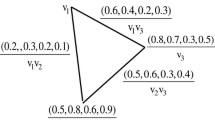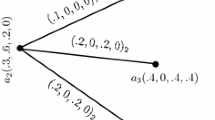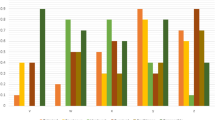Abstract
In the current decade, descriptive analysis of uncertainty existing in m-polar fuzzy attributes is addressed as one of the crucial tasks. To deal with these types of attributes mathematical algebra of m-polar fuzzy graph and its concept lattice representation was introduced recently. In this process, a problem is addressed when an expert wants to discover some useful pattern based on maximal acceptance of m-polar fuzzy attributes (or objects) for solving the particular issue of a given problem. To deal with this problem, the current paper focuses on drawing the object and attribute based m-polar fuzzy concept lattice using the projection operator. One of the suitable examples for the proposed method is also given with illustration of object and attribute based concepts. The analyses obtained from both of the proposed methods are compared with recently available approaches on handling the m-polar fuzzy attributes.



Similar content being viewed by others
References
Akram M, Younas HR (2017) Certain types of irregular \(m\)-polar fuzzy graphs. J Appl Math Comput 53(1–2):365–382
Aliev R, Memmedova K (2015) Application of Z–Number based modeling in psychological research. Comput Intell Neurosci. https://doi.org/10.1155/2015/760403 (Article ID 760403)
Antoni L, Krajči S, Krídlo O, Macek B, Piskova L (2014) On heterogeneous formal contexts. Fuzzy Sets Syst 234:22–33
Aswani Kumar C (2012) Knowledge discovery in data using formal concept analysis and random projections. Int J Appl Math Comput Sci 21(4):745–756
Bělohlávek R (2004) Concept lattices and order in fuzzy logic. Ann Pure Appl Logic 128(1–3):277–298
Bělohlávek R, Sklenǎŕ V, Zackpal J (2005) Crisply generated fuzzy concepts. In: International conference on formal concept analysis ICFCA 2005: Formal concept analysis. Springer, Berlin, Heidelberg, pp 269–284. https://doi.org/10.1007/978-3-540-32262-7_19
Berry A, Sigayret A (2004) Representing concept lattice by a graph. Discr Appl Math 144(1–2):27–42
Bravo G, Farjam M, Moreno FG, Birukou F, Squazzoni F (2018) Hidden connections: network effects on editorial decisions in four computer science journals. J Informetr 12(1):101–112
Burusco Juandeaburre A, Fuentes-González R (1994) The study of the L-fuzzy concept lattice. Math Soft Comput 1(3):209–218
Chen SM (1996) A fuzzy reasoning approach for rule-based systems based on fuzzy logics. IEEE Trans Syst Man Cybern Part B Cyber 26(5):769–778
Chen SM, Chen CD (2011) Handling forecasting problems based on high-order fuzzy logical relationships. Expert Syst Appl 38(4):3857–3864
Chen J, Li S, Ma S, Wang X (2014) m-Polar Fuzzy Sets: An Extension of Bipolar Fuzzy Sets. Sci World J. https://doi.org/10.1155/2014/416530 (Article ID 416530)
Chen SM, Lin TE, Lee LW (2014) Group decision making using incomplete fuzzy preference relations based on the additive consistency and the order consistency. Inf Sci 259:1–15
Chen SM, Munif A, Chen GS, Liu HC, Kuo BC (2012) Fuzzy risk analysis based on ranking generalized fuzzy numbers with different left heights and right heights. Expert Syst Appl 39(7):6320–6334
Chen SM, Tanuwijaya K (2011) Fuzzy forecasting based on high-order fuzzy logical relationships and automatic clustering techniques. Expert Syst Appl 38(12):15425–15437
Chen SM, Wang NY, Pan JS (2009) Forecasting enrollments using automatic clustering techniques and fuzzy logical relationships. Expert Syst Appl 36(8):11070–11076
Djouadi Y (2011) Extended Galois derivation operators for information retrieval based on fuzzy formal concept lattice. In: Benferhal S, Goant J (eds) SUM 2011, LNAI, vol 6929. Springer-Verlag, New York, pp 346–358
Dubois D, Prade H (2012) Possibility theory and formal concept analysis: characterizing independent sub-contexts. Fuzzy Sets Syst 196:4–16
Ganter B, Wille R (1999) Formal concept analysis: mathematical foundation. Springer-Verlag, Berlin
Ghosh P, Kundu K, Sarkar D (2010) Fuzzy graph representation of a fuzzy concept lattice. Fuzzy Sets Syst 161(12):1669–1675
Kumar CA, Singh PK (2014) Knowledge representation using formal concept analysis: a study on concept generation. Global trends in knowledge representation and computational intelligence. IGI Global Publishers, Hershey, pp 306–336
Lee LW, Chen SM (2015) Fuzzy decision making based on likelihood-based comparison relations of hesitant fuzzy linguistic term sets and hesitant fuzzy linguistic operators. Inf Sci 294:513–529
Loia V, D’Aniello G, Gaeta A, Orciuoli F (2016) Enforcing situation awareness with granular computing: a systematic overview and new perspectives. Granul Comput 1(2):127–143
Macko J (2013) User-friendly fuzzy FCA. Lect Notes Comput Sci 7880:156–171
Medina J, Ojeda-Aciego M (2012) On multi-adjoint concept lattice based on heterogeneous conjunctors. Fuzzy Sets Syst 208:95–110
Mesiarová-Zemanková A (2015) Multi-polar t-conorms and uninorms. Inf Sci 301:227–240
Mesiarová-Zemanková A, Ahmad K (2014) Extended multi-polarity and multi-polar-valued fuzzy sets. Fuzzy Sets Syst 234:61–78
Pandey LK, Ojha KK, Singh PK, Singh CS, Dwivedi S, Bergey EA (2016) Diatoms image database of India (DIDI): a research tool. Environm Tech Innov 5:148–160
Pedrycz W, Chen SM (2011) Granular computing and intelligent systems: design with information granules of high order and high type. Springer, Heidelberg
Pedrycz W, Chen SM (2015a) Granular computing and decision-making: interactive and iterative approaches. Springer, Heidelberg
Pedrycz W, Chen SM (2015b) Information granularity, big data, and computational intelligence. Springer, Heidelberg
Pollandt S (1997) Fuzzy begriffe. Springer-Verlag, Berlin-Heidelberg
Samanta S, Akram M, Pal M (2015) m-Step fuzzy competition graphs. J Appl Math Comput 47:461–472
Sarwar M, Akram M (2017) Novel applications of \(m\)-polar fuzzy concept lattice. New Math Nat Comput 13(3):261–287
Sebastian S, Ramakrishnan TV (2010) Multi-fuzzy sets. Int Math Forum 5(50):2471–2476
Sebastian S, Ramakrishnan TV (2011) Multi-fuzzy sets: An extension of fuzzy sets. Fuzzy Inform Eng 3(1):35–43
Singh PK (2016) Processing linked formal fuzzy contexts using non-commutative composition. Inst Integr Omics Appl Biotechnol (IIOAB) J 7(5):21–32
Singh PK (2017a) Three-way fuzzy concept lattice representation using neutrosophic set. Int J Mach Learn Cybernet 8(1):69–79. https://doi.org/10.1007/s13042-016-0585-0
Singh PK (2017b) Complex vague set based concept lattice. Chaos Solitons Fractals 96:145–153. https://doi.org/10.1016/j.chaos.2017.01.019
Singh PK (2018a) Interval-valued neutrosophic graph representation of concept lattice and its (\(\alpha, \beta, \gamma\))-decomposition. Arab J Sci Eng 43(2):723–740. https://doi.org/10.1007/s13369-017-2718-5
Singh PK (2018b) \(m\)-polar fuzzy graph representation of concept lattice. Eng Appl Artif Intell 67:52–62
Singh PK (2018c) Concept lattice visualization of data with \(m\)-polar fuzzy attribute. Granul Comput 3(2):123–137. https://doi.org/10.1007/s41066-017-0060-7
Singh PK (2018d) Similar vague concepts selection using their Euclidean distance at different granulation. Cogn Comput 10(2):228–241
Singh PK (2018e) Bipolar fuzzy graph representation of concept lattice. Soft Comput 67:52–62. https://doi.org/10.1007/s00500-018-3114-0
Singh PK, Aswani Kumar C (2012) A method for reduction of fuzzy relation in fuzzy formal context. Commun Comput Inform Sci 283:343–350
Singh PK, Aswani Kumar C (2014) Bipolar fuzzy graph representation of concept lattice. Inf Sci 288:437–448
Singh PK, Aswani Kumar C (2015) A note on computing crisp order context of a fuzzy formal context for knowledge reduction. J Inform Process Syst 11(2):184–204
Singh PK, Aswani Kumar C (2016) Analysis of composed fuzzy contexts using projection. Int J Data Anal Tech Strateg 8(3):206–219
Singh PK, Aswani Kumar C (2017) Concept lattice reduction using different subset of attributes as information granules. Granul Comput 2(3):159–173
Wang HY, Chen SM (2008) Evaluating students’ answerscripts using fuzzy numbers associated with degrees of confidence. IEEE Trans Fuzzy Syst 16(2):403–415
Wang C, Fu X, Meng S, He Y (2017) Multi-attribute decision-making based on the SPIFGIA operators. Granul Comput 2:321–332
Wille R (1982) Restructuring lattice theory: an approach based on hierarchies of concepts. In: Rival I (ed) Ordered sets, ordered sets, NATO advanced study institutes, vol 83. Springer, New York, pp 445–470
Yao YY(2004) A comparative study of formal concept analysis and rough set theory in data analysis. In: Proceedings of 4th international conference on rough sets and current trends in computing 2004, Uppsala, Sweden, pp. 59–68
Yao YY (2017a) Interval sets and three-way concept analysis in incomplete contexts. Int J Mach Learn Cybernet 8(1):3–20
Yao YY (2017b) A triarchic theory of granular computing. Granul Comput 1(2):145–157
Yuan M, Li W, Zhangang L (2009) Projection granular space in formal concept. In: 2009 WRI world congress on software engineering. IEEE, pp 94–98. https://ieeexplore.ieee.org/document/5319704/
Zadeh LA (1965) Fuzzy sets. Inf Control 8(3):338–353
Zadeh LA (1975) The concepts of a linguistic and application to approximate reasoning. Inf Sci 8:199–249
Zadeh LA (2011) A note on Z-numbers. Inf Sci 181:2923–2932
Acknowledgements
The author thanks the anonymous reviewers and the editor for their valuable suggestions and comments.
Author information
Authors and Affiliations
Corresponding author
Ethics declarations
Conflict of interest
The author declares that he has no competing interests.
Funding
Teh author declares that there is no funding for this research and analysis.
Additional information
Publisher's Note
Springer Nature remains neutral with regard to jurisdictional claims in published maps and institutional affiliations
Rights and permissions
About this article
Cite this article
Singh, P.K. Object and attribute oriented m-polar fuzzy concept lattice using the projection operator. Granul. Comput. 4, 545–558 (2019). https://doi.org/10.1007/s41066-018-0117-2
Received:
Accepted:
Published:
Issue Date:
DOI: https://doi.org/10.1007/s41066-018-0117-2




